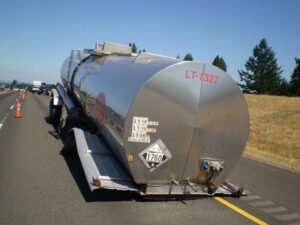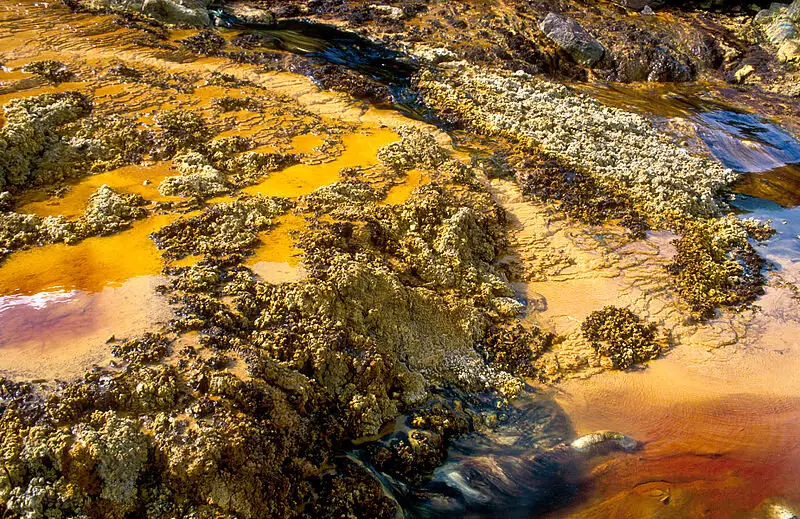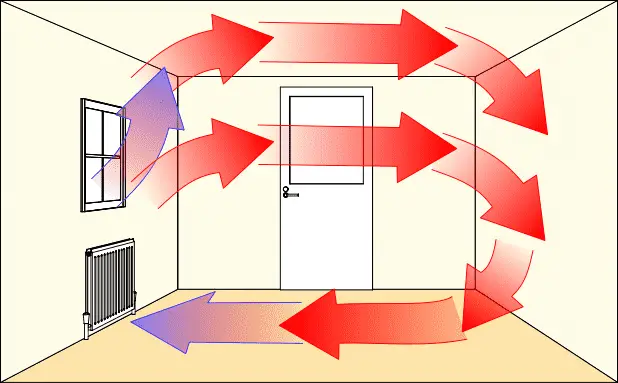5 Sources of Land Pollution and Characteristics Explained
Sources of land pollution are; oil vessels, waste facilities, industrial plants, mine sites, and unsustainable agricultural systems.
This article discusses the sources of land pollution and their characteristics, as follows;
1). Oil Vessels (Sources of Land Pollution)
The main source of oil pollution on land and in aquatic ecosystems like creeks, brackish wetlands and marine zones, is manmade vessels; which could be used for storage and/or transport of petroleum and its products.
Oil pollution can be defined as a form of environmental degradation where the primary pollutants are hydrocarbons derived from petroleum, or from any of its products like gasoline and some industrial chemicals.
The cause of oil pollution on the Earth's surface is usually oil spillage; which is an accidental occurrence in most cases, and can be traced to unreliable equipment, poor maintenance, mechanical pressure/collision, and various forms of human error.
Oil spill causes land pollution by releasing large quantities of hydrocarbon compounds that have a toxic effect, and tend to alter the physico-chemical makeup of topsoil and surface water in a negative way [2].
As a source of land pollution, oil vessels contribute to oil spills by leaking or spilling their content onto the Earth's surface.
The term 'vessels' with respect to oil-related land pollution, is a broad term that covers multiple concepts including automobile tankers, stationary storage containers, and transport conduits.
Vandalism, expiration or accidental rupture of any of these vessels is a major environmental issue in many parts of the world; especially where petroleum is abundant or prominently-used as an energy resource.
Oil vessels are particularly hazardous as a source of land pollution because of the toxic effect which their contents can have on soil and water. It is well known and documented that oil spills can degrade the value, safety and biological productivity of land, so that such land often becomes invalid for agricultural purposes [3].
Human exposure to oil-contaminated land also has health effects, and can lead to skin irritation, neurological and respiratory ailments [4].
Among the types of land pollution, oil-related cases can be classified as invasive; because hydrocarbons that have been deposited on the Earth's surface are highly volatile and have low density, both of which allow them to migrate into the atmosphere and hydrosphere. This explains why land pollution cases involving oil vessels (as a pollution/pollutant source) often have ripple environmental impacts that include water and air pollution.
Coastal areas particularly suffer from the effects of oil pollution both in water and on land, and this has led to the development of multiple regulations to control the handling of oil projects and products in such areas [1].
Lastly, the difficulty and cost of environmental remediation for cases of oil-related land pollution, may differ with factors like areal range of pollution, specific chemical composition of pollutants and vertical depth of pollutant-migration.

2). Waste Facilities
In many areas including urban, industrial and remote agricultural locations, waste facilities continue to act as a prominent source of land pollution annually.
A waste facility causes land pollution when it is not effectively managed in such a manner that ensure waste is confined only to the facility, and isolated from elements of the environment like soil, air and water.
An instance of such mismanagement can be observed in unsanitary landfills. Here, the process of landfilling and the containment of waste do not protect surrounding areas from degradation.
Absence of practices like waste burial, compaction, leachate collection and treatment, causes the land to be exposed to toxic waste materials and the byproducts of organic biodegradation; including greenhouse gases, odorous sulfuric gas, and leachate fluid.
Industrial waste facilities also act as sources of land pollution in cases where they are allowed to release their waste into the environment without any (or adequate) treatment.
Such practices occur in many industries that operate with minimal or no supervision or enforcement of environmental law.
The severity of land pollution from waste facilities may vary significantly from one case to another, depending on the type and magnitude of waste involved.
Chemical waste tends to be the most hazardous because of its ability to percolate through soil pores and deposit toxins in both soil and groundwater. On the other hand, municipal solid waste has a less-severe effect because it is often restricted to the surface.
Discussions surrounding waste facilities as sources of land pollution can be very broad, because most sources of pollution involve waste of some kind or another. This is why the issue of waste management and pollution can cover other topics like industrial pollution, mining and agriculture.
3). Industrial Plants (Sources of Land Pollution)
Industrial plants that act as sources of land pollution span across all sectors, including manufacturing, electricity generation, food production, construction, mining/raw material-extraction, and service-rendering fields.
The main cause of industrial land pollution is waste materials and byproducts released in the course of operation, in industrial plants.
Waste mismanagement can be blamed for a significant portion of land pollution cases where industrial facilities release the pollutants. Other factors include the type of raw materials used, equipment, and processing methods.
Addressing issues of land pollution industrial plants requires several concepts and practices to be considered. These include recycling, circular economy, raw material-substitution, green building, sustainable manufacturing, and clean energy development.
Integrating such practices into the framework of industrial operations can be beneficial to the ecosystem by reducing hazardous impacts.
4). Mine Sites
Mining for metallic ores and energy resources like coal, is a common attribute of industrialization that has huge implications for the environment. This is because of the impact of mining activities on soil, water and air quality.
Soil pollution often occurs around mine sites, as a result of contact between the waste materials from mining (also called mine-tailings) and the Earth's surface.
When ore is extracted crushed and processed, waste is produced in the form of slurry comprising water and fine particles, which can affect the soil [5].
Mine sites act as an invasive source of land pollution, because the pollutants on the surface can migrate by leaching [6], into adjacent areas including the subsurface and water bodies.

5). Unsustainable Agricultural Systems (Sources of Land Pollution)
Unsustainable agricultural systems can also serve as sources of land pollution. Such pollution can be alternatively referred to as agricultural pollution of land.
The term 'unsustainable agricultural systems' here refers to all entities in the field of agriculture that are capable of releasing toxic materials in the course of their lifecycle or operation. These include farm-based power plants, warehouses for agricultural chemicals (fertilizers, pesticides, herbicides), unmanaged compost bins, livestock housing facilities, agricultural lands with excessive chemical application, and biorefineries.
Toxic materials from these sources include chemical and biogenic materials that can alter the chemical equilibrium of soil on the Earth's surface.
Addressing land pollution from agriculture is possible through implementation of sustainable agricultural principles and practices.
Conclusion
Sources of land pollution are;
1. Oil Vessels
2. Waste Facilities
3. Industrial Plants
4. Mine Sites
5. Unsustainable Agricultural Systems
References
1). Anyanova, E. (2012). "Oil Pollution and International Marine Environmental Law." Sustainable Development - Authoritative and Leading Edge Content for Environmental Management. Available at: https://doi.org/10.5772/37399. (Accessed 7 May 2023).
2). Grifoni, M.; Rosellini, I.; Angelini, P.; Petruzzelli, G.; Pezzarossa, B. (2020). "The effect of residual hydrocarbons in soil following oil spillages on the growth of Zea mays plants." Environ Pollut. 2020 Oct;265(Pt A):114950. Available at: https://doi.org/10.1016/j.envpol.2020.114950. (Accessed 7 May 2023).
3). Inoni, O.; Omotor, D.; Nkem, A. F. (2006). "The effect of oil spillage on crop yield and farm income in Delta State, Nigeria." Journal of Central European Agriculture 7(1). Available at: https://www.researchgate.net/publication/27201796_The_effect_of_oil_spillage_on_crop_yield_and_farm_income_in_Delta_State_Nigeria. (Accessed 7 May 2023).
4). Kuppusamy, S.; Raju, M. N.; Mallavarapu, M.; Kadiyala, V. (2020). "Impact of Total Petroleum Hydrocarbons on Human Health." Total Petroleum Hydrocarbons (pp.139-165). Available at: https://doi.org/10.1007/978-3-030-24035-6_6. (Accessed 7 May 2023).
5). Mulenga, C. (2022). "Soil governance and the control of mining pollution in Zambia." Soil Security, Volume 6, March 2022, 100039. Available at: https://doi.org/10.1016/j.soisec.2022.100039. (Accessed 7 May 2023).
6). Terrones-Saeta, J. M.; Suárez-Macías, J.; Bernardo-Sánchez, A.; Álvarez de Prado, L.; Menéndez Fernández, M.; Corpas-Iglesias, F. A. (2021). "Treatment of Soil Contaminated by Mining Activities to Prevent Contamination by Encapsulation in Ceramic Construction Materials." Materials (Basel). 2021 Nov 9;14(22):6740. Available at: https://doi.org/10.3390/ma14226740. (Accessed 7 May 2023).




